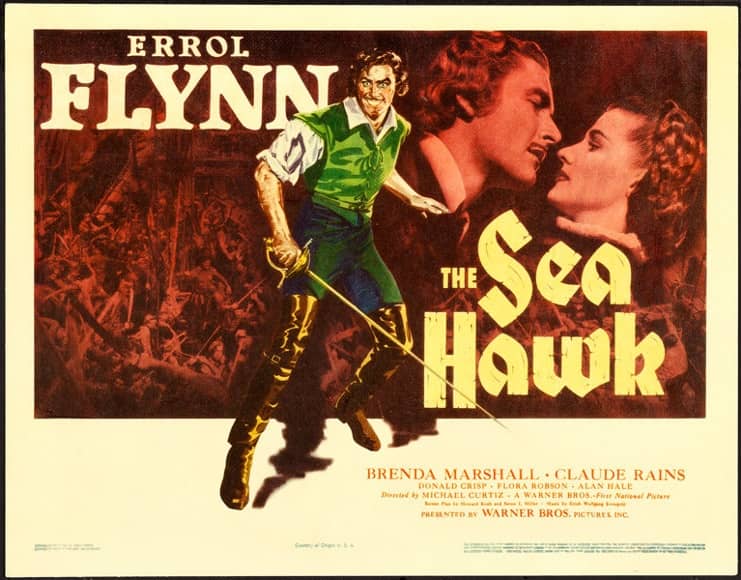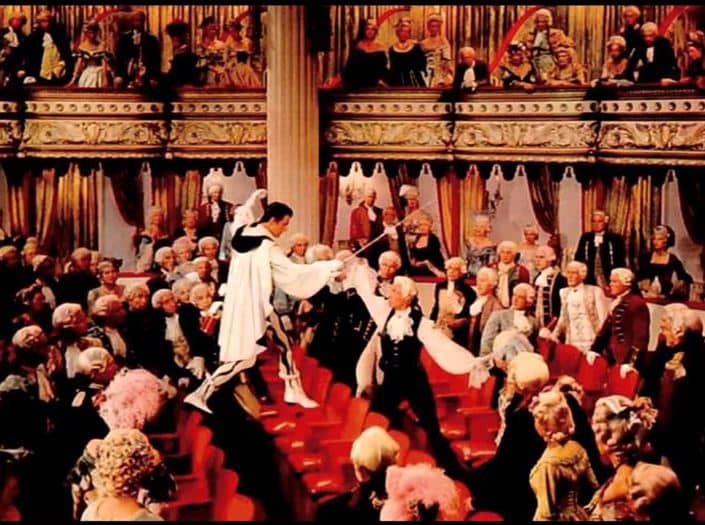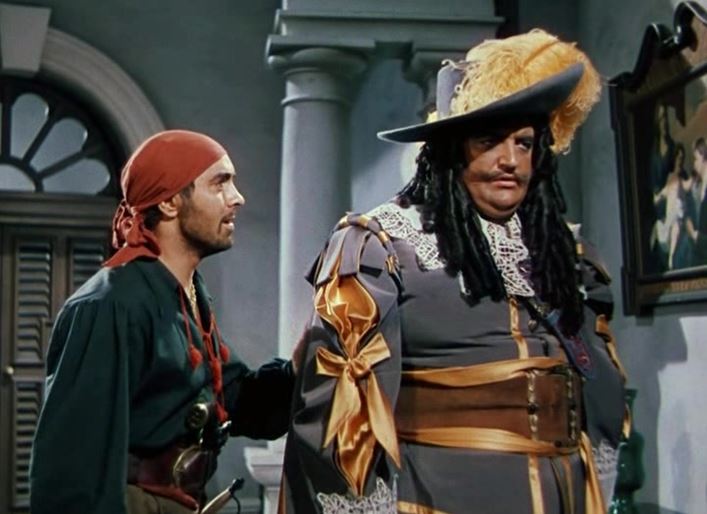Ellsworth’s Cinema of Swords: Beyond Captain Blood: Three by Sabatini
The Sea Hawk (Warner Bros, 1940)
We’ve already covered Errol Flynn’s breakthrough swashbuckler Captain Blood (1935) in this series, and you’ve probably seen and savored it, but you might not be familiar with Rafael Sabatini, the author who wrote the novel it was so memorably adapted from. In the Nineteenth Century Alexandre Dumas père was the king of historical adventure, but in the Twentieth Century that crown passed to Rafael Sabatini (1875-1950). Born in Italy, Sabatini was raised and schooled in Britain, Italy, and Switzerland, and was fluent in at least five languages. He settled in England in the early 1890s and in 1902 published The Suitors of Yvonne, the first of thirty-one historical novels, pretty much all of which can be classified as swashbucklers. In fact, in the early twentieth century the name Sabatini practically defined the genre. (He’s the only author who’s included twice in my Big Book of Swashbuckling Adventure anthology.)
Sabatini’s novels were perfect film fodder; a half-dozen of them made it to the screen in the silent era, and after the success of Flynn’s Captain Blood Hollywood revisited Sabatini’s backlist for another round in the forties and fifties. The three covered below are the best of the lot — and two of them are as good as it gets!
The Sea Hawk
Rating: ***** (Essential)
Origin: USA, 1940
Director: Michael Curtiz
Source: Warner Bros. DVD
Shortly after the success of Captain Blood (1935), Warner Bros. optioned Blood author Rafael Sabatini’s The Sea Hawk as a follow-up vehicle for Errol Flynn; but production was postponed, partly because the plot of Hawk was too similar to that of Blood. Several years passed, war between Britain and Germany began to appear inevitable, and the British production of Fire Over England (1937) provided a model for an American approach to the same historical events.
The Sea Hawk project was revived, retaining the title but with a new story by Howard Koch and Seton Miller (who a year later would write Casablanca), setting the tale during the run-up to the Spanish Armada and sending Flynn back to Elizabethan England for the second time in two years. Besides providing the model for the story, Fire Over England also gave The Sea Hawk its queen in the form of Flora Robson, reprising her memorable role of Elizabeth I.
The film starts with the English queen’s opponent, Spain’s King Philip II, sending his suave ambassador Don Alvarez (Claude Rains!) to England to string Elizabeth along while Spain builds her Armada for an invasion. Only England stands between a ruthless tyrant and his conquest of the world. (Sound familiar? The movie was released just before the beginning of the London Blitz.) However, when approaching England the ambassador’s galley, rowed by English slaves, is attacked by an English privateer captained by Geoffrey Thorpe (Flynn). Superior English gunnery, followed by a fierce boarding action (“It’s cutlasses now, men!”), carries the day; the slaves are freed, and Don Alvarez and his niece (the tepid Brenda Marshall) are captured. Thorpe wryly promises to deliver them to the queen — along with the treasure looted from their sinking galley. It’s just about the best first twenty minutes of any swashbuckler.
Meanwhile, England’s royal court teems with the schemes and intrigues of the queen’s ambitious advisors. Here comes the excellent Henry Daniell again, treacherously plotting once more—why wasn’t he run out of London after Elizabeth and Essex? But the queen is his match; when Daniell and Rains complain about the privateers, Elizabeth publicly reproaches the Sea Hawks, especially Thorpe — and then congratulates him in private. She even allows Thorpe to persuade her to give him tacit permission to attack the annual Spanish treasure convoy in Panama.
But there is treachery and Thorpe is betrayed, though the ambassador’s niece, who’s fallen in love with him, tries too late to warn him. In Panama Thorpe and his crew are captured and the Inquisition sentences them to life as galley slaves. And then things get serious.
With the great Michael Curtiz directing, Orry-Kelly on costumes, and a soundtrack, possibly his most magnificent, by Erich Wolfgang Korngold, Warners had their A-team on this picture, and it shows. Flora Robson is tremendous as Elizabeth, the escape of the galley slaves is taut and suspenseful, and Flynn gets to do some of his finest swashbuckling in the exciting finale. Watch for Fritz Leiber, Sr., in a brief role as the vulturine Inquisition judge, fine supporting work from Gilbert Roland as Captain Lopez, the only honorable Spaniard, and a mischievous pet monkey that will feel familiar to fans of the Pirates of the Caribbean series.
Scaramouche
Rating: ****
Origin: USA, 1952
Director: George Sidney
Source: Warner Bros. DVD
Born in Italy, the author Rafael Sabatini had lived in England since 1892 — but when the First World War broke out, faced with Italian conscription, he finally naturalized, then served throughout the war as a translator for British Intelligence. Though he never said why, working for the spy service darkened Sabatini’s worldview, and when he returned to writing after the war, his first novel was the bitter and scathing Scaramouche (1921), a best-selling story of romance, revolution, and above all, revenge. This MGM adaptation leaves out most of the politics, but the romance and revenge are front and center.
“He was born with a gift of laughter, and a sense that the world was mad”: this famous first line of the novel, inscribed as well on Sabatini’s tomb, also starts the film, though it will be awhile before we see the protagonist to whom it applies. First we’re introduced to the Duc de Maynes (Mel Ferrer), a sneering aristo whose hobby is picking fights with other men and then slaying them “honorably” in sword duels. The duke is gently scolded for this lethal pursuit by the Queen of France, who thinks he needs to settle down, and selects one of her demoiselles, Aline (Janet Leigh, radiant), to be his future bride. Her Majesty also complains about the rude political pamphlets written by a revolutionary under the pseudonym Marcus Brutus, and the duke vows to discover and deal with him in his usual fashion.
Background established, we finally meet André Moreau (Stewart Granger), a scapegrace young wit, romancer, and philosopher of life, as he pays a midnight visit to a traveling commedia dell’arte troupe to make love to its leading lady, Lenore (Eleanor Parker). Moreau is also besties with Philippe de Vilmorin, who is secretly the writer Marcus Brutus who’s being pursued by the duke’s goons. Moreau promises to help him but is unable to prevent de Maynes from maneuvering Philippe into a duel and killing him before his eyes. Moreau swears to avenge Philippe, but barely escapes himself and is forced to hide in Lenore’s comedy troupe, adopting the insolent role and impudent mask of Scaramouche. The laughing scoundrel finds a purpose at last.
Though Granger, when he came to MGM, stipulated in his contract that he get the lead in Scaramouche, he wasn’t ideal for the role: his mockery was joyless, and he lacked the comic touch for his bits with the commedia. In short, he wasn’t funny enough to be Sabatini’s scornful clown. And the less said about his unconvincing love scenes with Leigh and Parker, the better. However, Granger brought two powerful assets to the part, a feel for grim vengeance, and the skilled swordplay that’s central to the movie’s final third. There are fine learning-to-fence montages in the film as Moreau trains with two master swordsmen, scenes that reflect the serious training Granger himself undertook in preparation for the picture. He did his own stunts, and both Granger and Ferrer (a dancer, and it shows) did all their own fencing, most notably in the justly-famous seven-and-a-half-minute duel in a Paris theater that serves as the climax of the story. That duel alone is worth the price of admission and is a thoroughly satisfying payoff to the ninety minutes of set-up that give it weight. It’s probably the best scene with a hero clad in skin-tight striped leggings in all of cinema!
The Black Swan
Rating: ***** (Essential)
Origin: USA, 1942
Director: Henry King
Source: Fox Studio Classics DVD
Trust me, mates, this is one of the finest pirate movies ever made. It’s not as iconic or influential as Captain Blood or Treasure Island, but it’s every bit as good and deserves to be better known. Like Blood, it’s a reasonably close adaptation of a Rafael Sabatini novel, with crackling dialogue by Seton Miller (Adventures of Robin Hood, The Sea Hawk) and the great Ben Hecht (The Front Page, Gunga Din). It’s one of director Henry King’s many collaborations with star Tyrone Power, and the first of their series of swashbucklers. King understood that the audience wanted a vivid, fast-moving tale, and that Power was looking for roles with both strength and nuance to them. And in this Technicolor epic, the team delivered all of that.
This movie pulls no punches: even before the main titles, a pirate ship takes down an English merchantman, and immediately after the opening, two buccaneer crews raid and sack a Spanish colonial port. And these are real pirates, not Robin Hood’s Merrie Men: murder and pillage are rife, and rapine is implied. Less than five minutes into the film, Captain Jamie Waring (Power) and Captain Leech (George Sanders, that magnificent bastard) are lolling on the beach, splitting the spoils, as Waring laments the capture of their leader, Captain Henry Morgan. Then Spanish reinforcements counterattack, and Waring is captured and put on the rack by an oily Spanish Don who demands to know where Morgan really is. Boom! Pirates swarm the castle, Waring is freed, and in walks their commander, Captain Morgan himself.
So far, the movie’s been good, even better than good, but when Laird Cregar enters in the role of Henry Morgan, it’s elevated to remarkable. Because Cregar simply is Sir Henry Morgan, brought back from the dead after three centuries, more alive and larger in every way than every other person in Port Royal, Jamaica, and the entire Caribbean. His screen presence even out-powers Tyrone Power. Indeed, there’s only one other star in the film with the megawattage to match him….
Maureen O’Hara, of course, in the first of her many memorable swashbuckling roles, playing the fiery Lady Marguerite Denby, daughter of the Governor of Jamaica—that is, the former governor, since Morgan has replaced him. Pirate Jamie Waring and Lady Marguerite fall into smoldering love/hate at first sight, and off we go!
The plot works well, with plenty of moving parts that satisfy: new governor Morgan trying to compel peace, renegade pirates plundering the Main, treacherous nobles selling out to the sea rovers — events keep moving without ever getting too complicated. The real fun in the middle part of the film comes from the interactions between the respectable citizens and Morgan’s buccaneers — theoretically the swabs have been rehabilitated but they just can’t get the hang of polite society, because pirates gonna pirate.
Then treachery rears its head and we’re roaring into act three, bedad! Rather than tip the final twists and turns of the brilliant finale, I’ll just point out a few things about this movie that shouldn’t be overlooked. First, there’s a fine and flavorful score by Alfred Newman that sets the mood perfectly. Second, we get the reliably-rascally Anthony Quinn leering and wearing an eye patch as George Sanders’s second in command. And last but by no means least, it’s a thrill to report that the tavern where the pirates meet is called Ye Porker’s Sterne, with an appropriately lurid pictorial sign hanging above its front door. Bedad!
Previous installments in the Cinema of Swords:
Olivia de Havilland — First Queen of the Swashbucklers
Goofballs in Harem Pants
Disney’s Early Swashbucklers
‘50s Vikings – Havoc in Horned Helms
Laughing Cavaliers
Charming and Dangerous: Douglas Fairbanks, Jr.
Eleven Samurai: Early Chambara Classics
LAWRENCE ELLSWORTH is deep in his current mega-project, editing and translating new, contemporary English editions of all the works in Alexandre Dumas’s Musketeers Cycle. Three volumes are in print, with the fourth, Blood Royal, coming from Pegasus Books this fall. His website is Swashbucklingadventure.net.
Lawrence Ellsworth’s secret identity is game designer LAWRENCE SCHICK, who’s been designing role-playing games since the 1970s. He now lives in Dublin, Ireland, and is co-designing a new mobile RPG for the WarDucks game studio.



Something that’s always struck me about Scaramouche: despite being made in America in 1952, it’s absolutely a martial arts movie. The training montage, the avenge-my-master plot, the amazing earpiece duel — it’s all there.
Setpiece! Not earpiece! SETPIECE! Damn autocorrect.
Thank you, Mr. Ellsworth, for yet another sterling swashbuckler post and a salute to the magnificent Rafael Sabatini, fitting heir to the great Dumas!
All three of these films are entertaining (although Scaramouche the book is better than the film), but it is the Black Swan that is my favorite. Talk about a perfect cast and…Maureen O’Hara! Sigh.
Thank you again.
I enjoyed all three, but I love Scaramouche, as it has my favorite big-screen duel and fine wit in the dialogue.
“ but you might not be familiar with Rafael Sabatini” or, you might have spent 99cents for the Sabatini Megapack at Amazon.